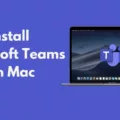Microsoft Teams, the popular collaboration platform, has recently announced that it has fully optimized its software for Apple Mac devices running on the latest macOS Monterey. This means that Teams will now run natively on the entire Mac lineup, including the new M1 or M2 chips. This is great news for Mac users who rely on Teams for seamless communication and collaboration.
Installing Microsoft Teams on your Mac is a simple process. Whether you have a PC, Mac, or mobile device, you can easily install Teams and start using it right away. To install Teams on your Mac, follow these steps:
1. Start by opening the Teams website or visiting the Mac App Store.
2. Locate the Teams app and click on the “Get” or “Install” button.
3. Depending on your browser or the App Store, you may need to enter your Apple ID password to proceed with the installation.
4. Once the installation is complete, you can launch Teams from your Applications folder or directly from your Dock.
Once you have Teams installed on your Mac running macOS Monterey, you may encounter some issues like Teams not loading or freezing. In such cases, a simple solution is to clear the cache memory. The cache memory stores temporary files and data, and over time, it can become overloaded and cause performance issues. To clear the cache in Teams, follow these steps:
1. Quit Microsoft Teams if it’s currently running on your Mac.
2. Open a Finder window and click on “Go” in the top menu.
3. Select “Go to Folder” and type in “~/Library/Application Support/Microsoft/Teams/Cache”.
4. This will open the Teams cache folder. Select all the files and folders within it and delete them.
5. Empty your Trash to completely remove the cache files.
Once you’ve cleared the cache, restart Microsoft Teams, and you should notice improved performance and a smoother experience.
With the recent optimization for Apple silicon, Teams on macOS Monterey now offers even better performance and efficiency on Mac devices with M1 or M2 chips. This means that Teams will take full advantage of the capabilities of these chips, resulting in faster and more responsive performance.
Teams on macOS Monterey also brings enhanced features and functionalities. Users can expect a seamless and integrated experience across their Mac devices, allowing them to effortlessly join meetings, collaborate on documents, and communicate with their colleagues.
Microsoft Teams has made significant improvements for Mac users with the optimization for macOS Monterey. With native support for Apple silicon, better performance, and enhanced features, Teams is now the perfect match for Mac users who rely on efficient and seamless collaboration. So, if you’re a Mac user, make sure to update to macOS Monterey and enjoy the optimized Teams experience on your Apple device.

Is Microsoft Teams Available For macOS?
Microsoft Teams is available for MacOS. MacOS users can easily download and install the Microsoft Teams client on their devices. The client can be obtained from the official Microsoft website or through the Mac App Store. Once installed, users can access all the features and functionalities of Teams on their Macs.
In addition to the client, MacOS users can also access Microsoft Teams via a web browser. This means that even if they do not want to install any software on their devices, they can simply open a web browser and log in to the Teams web app to use the platform.
Microsoft Teams is designed to be compatible with various operating systems, including MacOS, ensuring that users on different devices can collaborate and communicate seamlessly.
How Do You Allow Teams to Share Screen on Mac Monterey?
To allow Microsoft Teams to share screen on Mac Monterey, you will need to follow these steps:
1. Open the System Preferences on your Mac. You can do this by clicking on the Apple menu in the top-left corner of the screen and selecting “System Preferences.”
2. In the System Preferences window, click on the “Security & Privacy” icon. This icon looks like a padlock.
3. In the Security & Privacy settings, make sure you are on the “Privacy” tab. You will see a list of different categories on the left-hand side.
4. Scroll down the list and click on “Screen Recording.” This option allows you to control which apps can capture your screen.
5. On the right-hand side, you will see a list of apps that are currently allowed to capture your screen. Look for “Microsoft Teams” in the list.
6. If the checkbox next to Microsoft Teams is unchecked, click on the checkbox to allow screen sharing and capture for Teams.
7. When you click the checkbox, you may be prompted to enter your Mac’s administrator username and password. This is to ensure that only authorized users can make changes to these settings. Enter the required information and click the “Unlock” button.
8. Once you have allowed screen sharing for Microsoft Teams, you can close the System Preferences window.
By following these steps, you have successfully allowed Microsoft Teams to share screen on your Mac running Monterey. Now you can easily share your screen during Teams meetings and collaborations.
Why Microsoft Teams Not Working On Mac?
There are several reasons why Microsoft Teams may not be working on your Mac. Let’s explore some possible causes:
1. Outdated software: Ensure that both your Mac operating system and Microsoft Teams app are up to date. Outdated software can lead to compatibility issues and cause the app to malfunction.
2. Internet connection: Check your internet connection to ensure that it is stable and working properly. A weak or intermittent internet connection can disrupt the functioning of Microsoft Teams.
3. Full cache memory: If your cache memory is full, it can cause performance issues and prevent Microsoft Teams from loading properly. Clearing the cache can help resolve this problem.
4. Corrupted cache files: Over time, cache files can become corrupted, leading to software malfunctions. Deleting the corrupted cache files for Microsoft Teams may resolve the issue.
5. Conflicting applications: Sometimes, other applications running on your Mac can conflict with Microsoft Teams, causing it to crash or not load properly. Check for any recently installed or updated applications that might be causing the conflict.
6. Insufficient system resources: If your Mac does not meet the minimum system requirements for Microsoft Teams, it may not function correctly. Ensure that your Mac has enough memory, processing power, and available storage space.
7. Firewall or security settings: Sometimes, firewall or security settings on your Mac can block the necessary connections for Microsoft Teams. Review your firewall and security settings to ensure they are not interfering with the app.
8. User account issues: Occasionally, issues with your user account can prevent Microsoft Teams from working correctly. Try logging in with a different user account to see if the problem persists.
If you have tried all these solutions and Microsoft Teams still isn’t working on your Mac, it may be helpful to contact Microsoft support for further assistance.
Is Microsoft Teams Optimized For Mac?
Microsoft Teams has been fully optimized for Mac devices with Apple M1 or M2 chips. This means that the Teams platform has been specifically developed to run natively on the entire Mac lineup, providing a seamless and efficient experience for users.
Here are some key points about the optimization of Microsoft Teams for Mac:
1. Compatibility: Microsoft has ensured that Teams is fully compatible with the latest Apple silicon chips, including the M1 and M2. This ensures that Teams can take full advantage of the performance and capabilities offered by these chips.
2. Native Support: With the optimization for Apple silicon, Teams is able to run natively on Mac devices. This means that the software is designed to work directly with the hardware, resulting in improved performance, faster response times, and better overall user experience.
3. Enhanced Efficiency: The optimization for Mac devices with M1 or M2 chips allows Teams to make efficient use of system resources, leading to better power management and longer battery life for Mac users. This is particularly important for users who rely on Teams for extended periods or during meetings and conferences.
4. Seamless Integration: Microsoft Teams is a robust collaboration platform, and the optimization for Mac ensures that users can seamlessly integrate it into their workflows. Whether it’s joining meetings, sharing files, or collaborating on documents, Teams on Mac provides a consistent and reliable experience.
5. Feature Parity: The optimization of Teams for Mac ensures that users on Apple devices can enjoy the same features and functionalities as their Windows counterparts. This includes capabilities such as video calls, chat messaging, file sharing, screen sharing, and integration with other Microsoft 365 apps.
Microsoft Teams has been fully optimized for Mac devices with Apple M1 or M2 chips, allowing for a native and efficient experience on the entire Mac lineup. Users can expect improved performance, better power management, and seamless integration with other Microsoft 365 apps.
Conclusion
Microsoft Teams is fully compatible with macOS Monterey, ensuring seamless communication and collaboration for Mac users. With the ability to install Teams on various devices, including PCs, Macs, and mobile devices, users can easily access the platform and stay connected from anywhere. Additionally, Teams can be accessed via a web browser, providing flexibility and convenience.
For Mac users, installing Teams is a straightforward process, and they can make necessary changes by unlocking the settings with their administrator username and password. Enabling screen sharing and capture further enhances the collaborative experience within Teams.
In recent news, Microsoft has announced that Teams has been fully optimized for Apple Mac devices with M1 or M2 chips. This development means that Teams will run natively on the entire Mac lineup, ensuring efficient performance and a seamless user experience. This optimization is a significant step forward in providing Mac users with a tailored and optimized Teams experience.
In cases where Microsoft Teams fails to load on Mac, a possible solution is to clear the cache memory or corrupted cache files. Accumulated cache files can slow down the device and lead to program crashes. Therefore, regularly clearing the cache can help resolve any performance issues.
With its compatibility, optimization for Apple silicon, and the ability to clear cache, Microsoft Teams ensures that Mac users can utilize the platform effectively, enhance productivity, and collaborate seamlessly with their teams.








